Table of contents
- Six high-end textile suits in the MOTORRAD product test Six high-end textile suits in the MOTORRAD product test
- Gore is the top dog
- Lockout closure disappointed
- Practical breathable rain cover
- No optimal strength of the protectors
- Buy right: textile suits
- Material ABC
- Alpinestars – Tech ST Gore-Tex
- Dane – Limfjord / BrØndby
- IXS – Nimrod / Hamilton
- Rev’it – sand 2
- Rukka – Cosmic
- Stadler – Destiny Evo / Faith Evo
- The protectors in the test
- Bones can break at less than 10 kN
- Conclusion and final evaluation
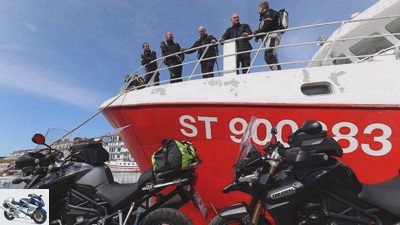
Jahn
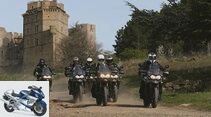
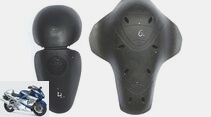
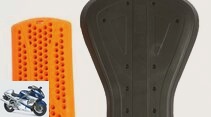
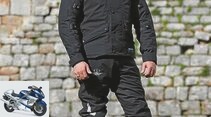
11 pictures
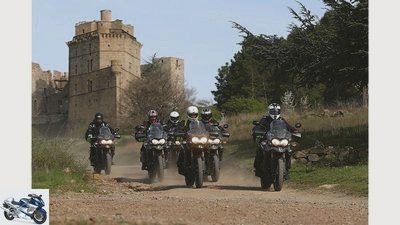
Jahn
1/11
What to wear for the discovery tour over gravel and asphalt in sun, wind and rain?
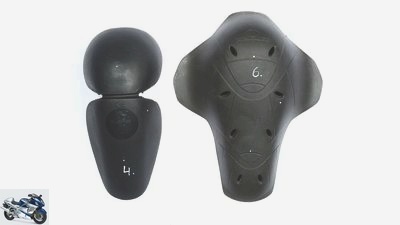
mps photo studio
2/11
Minimal versus optimal: joint protector of the Rev’it combination (left) compared to the Stadler bone protector.
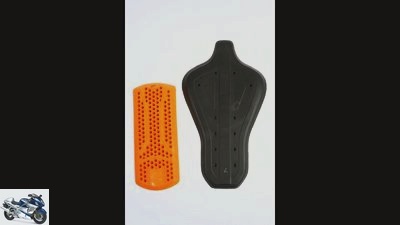
Jahn
3/11
Other protectors: what to protect? Rukka (left) only covers the spine, while Stadler covers almost the entire back.
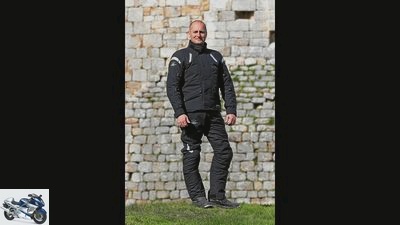
Jahn
4/11
Innovative touring combination “from Germany”. The functionally equipped, light summer suit Destiny Evo / Faith Evo by Stadler is combined with a solid Gore-Tex throw on rainy days. Very nicely made, protector set that looks exemplary.
MOTORRAD verdict: very good
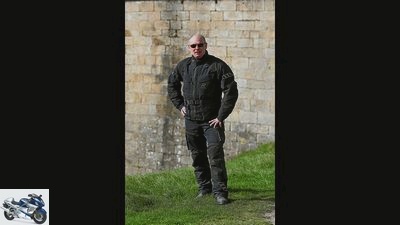
Jahn
5/11
A station wagon the equivalent of a solid used motorcycle. One of the strengths of the Rukka Cosmic suit is the absolutely convincing quality of workmanship. After the 4,000-kilometer test lap, it still looks fresh from the store.
MOTORRAD verdict: good
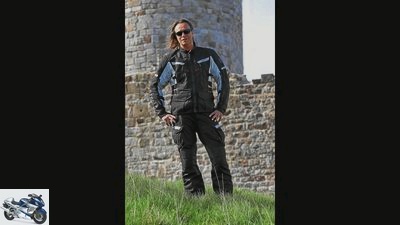
Jahn
6/11
The cheapest combination Sand 2 from Rev’it shows no real nakedness on the 4,000-kilometer test lap, even compared to suits that are twice as expensive, but it is annoying in details (partly stiff press studs). A great plus: the expansion options.
MOTORRAD verdict: good

Jahn
7/11
The Ixs-Kombi Nimord / Hamilton is with the considerable
Size selection and pants for short and long legs are just the thing for “problematic” figures. The insulation suits the classic motorcycle season in Central Europe. Commendable: the back protector!
MOTORRAD verdict: good
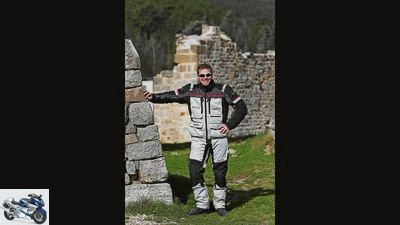
Jahn
8/11
The all-year-round suit Limfjord / Brondby by Dane for frequent riders on large travel enduros and touring machines. The only thing missing was a high storm collar and better cushioning protectors. Overall, however, the price-performance ratio is right.
MOTORRAD verdict: good
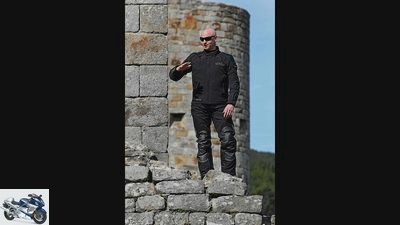
Jahn
9/11
The Alpinestars Tech ST Gore-Tex combination scores with great comfort on warm summer days and excellent rain protection. In the cold, it kneels quickly despite the thermal lining and storm collar. More is possible with the protector equipment.
MOTORRAD verdict: good
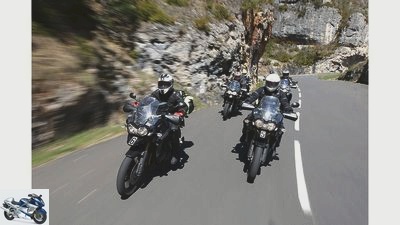
Jahn
10/11
From the gravel road to a brisk ride over winding asphalt: The demands on the textile suits are high.
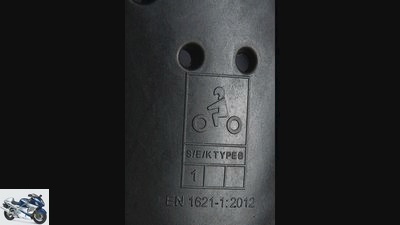
Jahn
11/11
This is what protection will look like in the future: Joint protector according to the revised standard EN 1621-1: 2012. S / E / K denotes the installation position (shoulder, elbow, knee), the size is indicated by the type (A for children and small women sizes , B for standard sizes). The number indicates which limit values (here level 1) are being adhered to.
clothing
Station wagons, jackets & pants
Product test: textile suits
Six high-end textile suits in the MOTORRAD product test
Six high-end textile suits in the MOTORRAD product test
Crossing Europe in wind and weather on dusty slopes: Discovering foreign worlds is still very popular in the 21st century. Only chain mail is no longer in vogue. The motorized riders rely on high-tech fibers for their own protection. Six luxury-class textile suits have to prove themselves on a 4,000-kilometer test lap.
Jorg Lohse
07/29/2013
China. Zack, that’s sitting. with Rukka Another premium textile supplier that had previously had production in Europe has now moved to far-off Asia. After all, press man Knut Briel tries to dissuade, the Finnish L-Group, as Rukka’s parent company, set up its own factory when it relocated production from Portugal to the Middle Kingdom: “So that the advantages of the production location such as wage levels or know-how are not combined with the disadvantages In any case, Briel is firmly convinced that nothing will change in the quality of Rukka in order to produce such as low flexibility or inadequate quality control.
Buy complete article
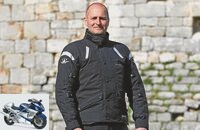
Test winner textile suits (MOTORRAD 17/2013)
Stadler Destiny Evo / Faith Evo
6 pages) as PDF
€ 2.00
Buy now
But not in terms of price either: at well over 1,600 euros, the “Cosmic” suit ranks a mere 1,000 euros above the cheapest supplier in this test, the textile suit “Sand 2” from the Dutch manufacturer Rev’it, which is also manufactured in Asia. Just a few euros from Rukka’s chinaware, Stadler’s Evo collection – consisting of a “Destiny” jacket and “Faith” trousers – hangs on the hanger for a set price of 1648 euros. After all, the medium-sized company from Bavaria tailors the collection for this at its home location in Aidenbach or in its own production facility in Croatia.
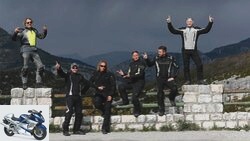
Station wagons, jackets & pants
6 textile suits in the test
Motorcycle suits from 700 to 2,200 euros
read more
Gore is the top dog
Whether the sewing machines are rattling in Asia or Europe: In terms of quality, all six suits cannot be distinguished in this test. If the brand names and logos were masked off, even an insider would have problems arranging them correctly in the order of the sales prices. A high standard has undoubtedly established itself in the luxury class station wagons; It is becoming increasingly difficult to distinguish them visually or haptically alone!
It starts with the choice of fabrics and materials. The company W. L. Gore has firmly established itself as the top dog for weather protection in the 1000 Euro league. There is hardly a well-known clothing manufacturer in the motorcycle scene who would like to do without the know-how of the US air conditioning specialists. That is not by accident. Gore took on the peculiarities of moisture protection for motorcyclists at an early stage, and older people are guaranteed to remember the legendary Thermoboy, which was already available three decades ago with a Gore-Tex climate membrane.
Since then, the potential of the wafer-thin, microporous but waterproof film has been pushed forward at the various production sites. In Feldkirchen near Munich, for example, there is a large rain tower. If motorcycle clothing wants to bring a new suit with a Gore-Tex climate membrane onto the market, the wetness test must first be completed at Gore itself.
Lockout closure disappointed
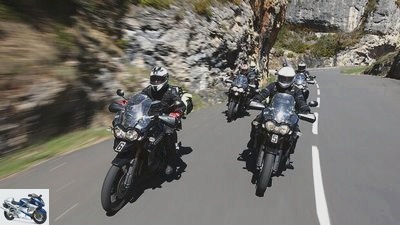
Jahn
From the gravel road to a brisk ride over winding asphalt: The demands on the textile suits are high.
If the construction shows weaknesses that make the motorcycle dummy look like a doused poodle, the product developers of the suit have to put in a few extra layers before approval is finally given. Of course, Gore’s creative minds also have to accept low blows time and again. Around four years ago, a waterproof alternative to conventional zippers was presented with great fanfare. The aim was to seal one of the neuralgic places where rain can seep into the inside of a jacket or pants, so to speak foolproof. With little success: In almost every test by MOTORRAD, the so-called lockout closure from Gore failed, in principle comparable to resealable plastic bags.
In everyday use, the testers complained about suddenly opening rubber lips or an increasingly difficult operation, which should ultimately be remedied by permanent lubrication with an enclosed silicone pen. In the end, most clothing brands also found that it was not practical and moved away from the alternative closure. This test once again proves that you don’t have to drown with conventional closure technology. In any case, there was no water ingress in any of the equipment on the sometimes hours-long rainy stages of the 4000-kilometer test lap as part of the MOTORRAD tire test.
Practical breathable rain cover
However, this required special care when putting them on. In the case of jackets in particular, it is important to carefully close the labyrinth strips, which are sometimes difficult to operate and which are supposed to seal the zip to the chest. Particularly in the so-called hybrid station wagons from Dane, Ixs and Rev’it, where the entire Gore-Tex inlay can be removed for airy summer rides, closing requires some effort. But the wearer of the similarly designed Stadler suit can save himself.
This also includes an open-pored summer suit, but the Gore moisture barrier is not pulled into the jacket and pants, but rather over it. Which has practical benefits on the go. If dark clouds suddenly appear on a hot day, the breathable rain cover is simply pulled over it. The other station wagons, which have been rebuilt for maximum ventilation, would first have to be completely pulled out for dismantling, so that the waterproof inlay can be laboriously fumbled in again.
In practice, of course, nobody would do this in a hurry, but rather decide before the start of the tour whether to ride with or without rain protection for the day. No light without shadow: the Stadler pilot has to haul more heavily in the rain. The outer fabric of the three-layer laminate must be appropriately robust and, at just under two kilos, weighs around twice as much as a conventional waterproof inlay.
No optimal strength of the protectors
On the other hand, the Stadler-Kombi is right with the fit, especially in summer: If the thickly padded thermal lining and the fluffy climate insert are removed from the competitors, they inevitably sit more loosely on the body, even if you try to adjust the seat using various width adjusters trim a little finer on the sleeves, hips and legs. That is not really optimal. This is particularly noticeable at critical points such as the protectors, which in textile suits do not enclose the joints with the optimal strength, as is the case with leather suits.
After all, in the high-end textile sector in particular, you can now rely on a significantly better fit. The days when you fluttered through the wind like a fluffy Michelin man are over in the Champions League thanks to a multitude of new elastic fabrics, neuralgic (fall) areas are reinforced with leather or tear-resistant Kevlar fibers. And there is also a wide selection of sizes. For “problem figures” there are pants in short or long sizes from almost every supplier. The air is only getting thinner and thinner for consumers who want to shop according to the principle of “Ride global, buy local”. Now that Rukka has also relocated production to China …
Buy right: textile suits
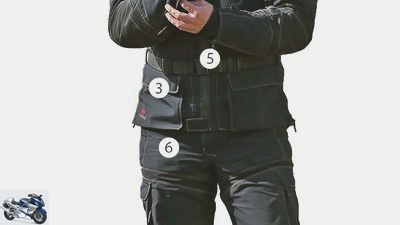
Jahn
Description of the individual points in the text.
The right collar size
What is best to wear for the discovery tour over gravel and asphalt in sun, wind and rain? The price is not critical. It is much more important that textile suits convince with practical solutions. A lot sounds impressive on paper, but rely on the practical test when trying on: Are all zips and press studs easy to close, and are the pockets easily accessible? You should pay particular attention to these points:
1) collar: A high degree is just as important as a fastener that is easy to use. Magnetic solutions are great, but they have to be strong enough.
2) protectors: All joints including hips, back and, if possible, the chest should have CE-
standardized lintel cushions.
3) Bags: It’s not the quantity that counts, the quality counts. Two waterproof outer pockets (identification!) And two easily accessible inner pockets are sufficient.
4) Sleeves: Only a wide opening guarantees that glove cuffs can be neatly stowed under the sleeves. Smart: waterproof stretch cuffs.
5) Front zip: one of the neuralgic points at which water penetrates. Beware of bulging labyrinth entrances that take time and nerves.
6) overlap: the second danger point where there is a risk of water ingress. The climate membrane of the jacket and pants must overlap sufficiently.
7) Reinforcements: Exposed areas such as shoulders,
Elbows and knees must be reinforced with particularly wear-resistant material.
8) leg end: must not slide up while sitting, should cover the boot shaft and be tightly closed.
Material ABC
Armacor, Bio-Armor, Cordura 1000, Outlast, space-tested … There are usually umpteen labels dangling from the station wagons in the store, but usually not even the salesman can explain them. A lot is of course self-important marketing talk. But what is really important? Our MOTORCYCLE ABC for a quick tour through the textile world:
Aramid: refers to a nylon synthetic fiber that is very tear, abrasion and heat resistant. Is often used for fabric reinforcement, mostly under brand names such as Kevlar or Armacor
Breathable: actually pure nonsense, because which tissue breathes by itself? It is often used as a synonym for the vapor permeability of a climate membrane. The principle: sweat evaporates and gets to the outside through a waterproof film via micropores (Gore-Tex) or a physical-chemical process (e.g. Sympatex).
Cordura: Brand name for a textile fiber that is widely used in motorcycle clothing. Consists of polyamide, is particularly abrasion and wear-resistant, insensitive to dirt and windproof. Particular strength: absorbs little water
Denier: Unit of measurement for textile fibers, with which the weight per 9000 meters of thread length is given in grams. In the motorcycle sector, the fabric should be at least 500 D, better 1000 D in exposed areas.
Fleece (fiber fur): Brushed polyester fabric that practically does not absorb moisture, is light and yet voluminous. Is z. B. used as a warming lining on the collar. The thermal lining itself usually consists of polyester hollow fibers (“Thermolite”).
Impregnation: should be part of the standard equipment of motorcycle clothing so that the outer fabric remains water-repellent. Depending on the provider, the impregnation applied during manufacture can be refreshed after washing in the dryer or by ironing.
Alpinestars – Tech ST Gore-Tex
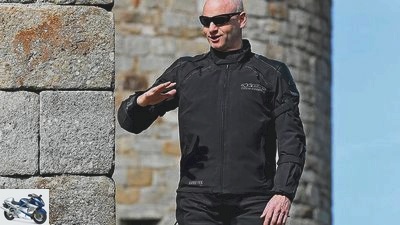
Jahn
The Tech ST Gore-Tex combination from Alpinestars.
providers: Alpinestars, phone 00 39/04 23/52 86, www.alpinestars.com; Price: Jacket 799.95 euros, pants 599.95 euros, complete 1399.90 euros; Sizes: Men 48 to 60; Colour: Black; Weight: 4.2 kg (size 50); Country of Manufacture: Indonesia; Furnishing: Gore-Tex climate membrane, removable thermal lining, removable fleece storm collar, removable braces.
Fit / comfort
Fits very tight with thermal lining – in combination with two layers of functional underwear (base and midlayer) you feel very cramped. On the other hand, it is ideal to wear in summer: Without a lining, it fits as comfortably as a leotard.
Weather protection
With the soft, tight-fitting storm collar and the low back section, cool drafts are effectively blocked out. The thermal lining itself insulates too weakly. The air conditioning is much more pleasant on hot days thanks to good ventilation. When it rains, the station wagon is 100 percent watertight.
security
Well-cushioning joint protectors, but important areas (back, chest) can only be protected at an additional cost.
Equipment / processing
High quality materials, clean design.
Conclusion
The Alpinestars combination scores with great comfort on warm summer days and excellent rain protection. In the cold, it kneels quickly despite the thermal lining and storm collar. More is possible with the protector equipment.
MOTORRAD verdict: good
Dane – Limfjord / BrØndby
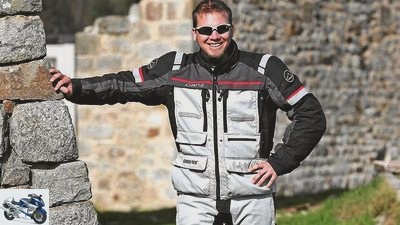
Jahn
The Limfjord / BrØndby textile combination by Dane.
Providers: Motoport, phone 0 44 51/91 52 00, www.motoport.de; Price: Jacket EUR 579, trousers EUR 399, complete EUR 978; Sizes: Men 48 to 64, trousers available in short and long sizes; Colour: Gray / silver / black; Weight: 4.1 kg (size 52); Country of Manufacture: Indonesia; Furnishing: removable Gore-Tex climate membrane, removable thermal lining.
Fit / comfort
At first glance, it looks very generous due to the multi-layered structure (extra Gore-Tex inlay, thermal lining), but fits very body-hugging thanks to the supple, partly elastic fabric structure. The crisp, comfortable, flutter-free seat is retained even when converted into a pure summer combination.
Weather protection
Offers plenty of comfort all year round. The multi-layer structure provides a very good insulation effect in the cold, after removing the thermal lining and Gore-Tex inlay, a fresh wind whistles through large ventilation openings. No failures when driving in the rain for several hours.
security
Joint protectors with average damping values. More protection (back, hips) is only available at an additional cost.
Equipment / processing
Top processed, very good choice of materials.
Conclusion
The year-round suit for frequent riders on large travel enduros and touring machines. The only thing missing was a high storm collar and better cushioning protectors. Overall, however, the price-performance ratio is right.
MOTORRAD verdict: good, best buy
IXS – Nimrod / Hamilton
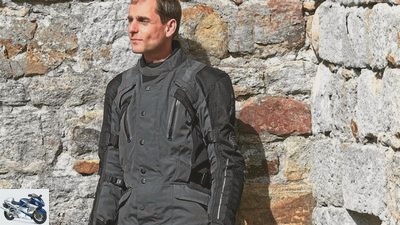
Jahn
IXS Nimrod / Hamilton textile suit.
Providers: Hostettler, phone 0 76 31/1 80 40, www.ixs.de; Price: Jacket 599.90 euros, pants 379.90 euros, complete 979.80 euros; Sizes: S to 5XL, trousers available in short and long sizes; Colour: Black, dark gray / black, light gray / black / red; Weight: 4.5 kg (size S); Country of Manufacture: Vietnam; Furnishing: Removable thermal lining, jacket with removable Gore-Tex climate membrane, reflective insert on the back, pants with a heat-reflective coating.
Fit / comfort
Tight cut, but supple fabric. The Ixs-Kombi impresses with its “full equipment” as well as after being converted into a summer suit (without Gore-Tex inner jacket and thermal lining) with its crisp, comfortable fit. Small losses due to pressure points on the cuffs.
Weather protection
Cozy warm on cold spring and autumn days, but insufficiently ventilated at high summer temperatures. The moisture protection is good, but seepage water that drips from the helmet soaks the collar area.
security
Joint protectors with good cushioning behavior, plus a very good back protector.
Equipment / processing
Great details, neat style.
Conclusion
The Ixs-Kombi is just right for “problematic” figures with its considerable size selection and trousers for short and long legs. The insulation suits the classic motorcycle season in Central Europe. Commendable: the back protector!
MOTORRAD verdict: good
Rev’it – sand 2
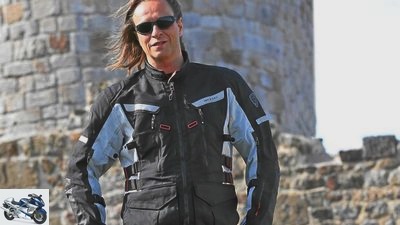
Jahn
The textile suit Sand 2 by Rev’it.
Providers: Rev’it Sport, phone 00 31/4 12/69 67 40, www.revit.eu; Price: Jacket EUR 349.99, trousers EUR 249.99, complete EUR 599.98; Sizes: S to XZL, trousers available in short and long sizes; Colour: Black / silver, black / orange, silver / black, silver / red, silver / blue; Weight: 4.3 kg (size XL); Country of Manufacture: Vietnam; Furnishing: Removable Hydratex climate membrane, removable thermal lining, prepared for coupling with a neck brace (“Neckbrace”) and a safety vest, the use of a drinking bag and a cooling vest.
Fit / comfort
It bulges slightly due to the multi-layer structure, similarly designed suits (Dane, Ixs) sit more supple. Can be trimmed in shape after converting it to a summer combination (without climate membrane and thermal lining), but the tendency to flutter remains.
Weather protection
Insulates great on cold days, pleasantly ventilated in the heat, effectively protects against rain. Small drawback: annoying drafts on the neck.
security
Only standard: joint protectors with average damping behavior.
Equipment / processing
Solidly processed, diversely expandable.
Conclusion
The cheapest station wagon is no real nakedness on the 4,000-kilometer test lap, even compared to suits that are twice as expensive, but it is annoying in details (partly stiff press studs). A great plus: the expansion options.
MOTORRAD verdict: good
Rukka – Cosmic
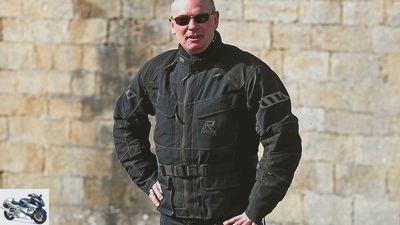
Jahn
Rukkas textile suit Cosmic.
Providers: Rukka Germany, phone 0 40/5 51 10 55, www.rukka.com; Price: Jacket 925 euros, trousers 699 euros, complete 1624 euros; Sizes: Men 46 to 62 (in black to 66), trousers available in short and long sizes; To dye: Black, beige, red; Weight: 6.3 kg (size 56); Country of Manufacture: China; Furnishing: Gore-Tex climate membrane, removable thermal lining, removable Gore-Tex storm collar, magnetic closures.
Fit / comfort
Due to the climate membrane that is firmly glued to the outer fabric, the station wagon is a little lacking
smoothness that the competitors with “loose” Z-Liner air conditioning have to offer in the test. Together with the comparatively high weight, there is a slight lack of mobility.
Weather protection
In the cold, despite the thermal lining, you quickly get a slight feeling of cold, and base and midlayers are essential at the start and end of the season. But moisture and wind protection are great.
security
Exemplarily equipped: joint protectors including full hip and back protection with brilliant cushioning, plus the extensively reinforced outer skin.
Equipment / processing
Well thought out and clean.
Conclusion
A station wagon the equivalent of a solid used motorcycle. One of the strengths of the Rukka suit is the absolutely convincing quality of workmanship. After the 4,000-kilometer test lap, it still looks fresh from the store.
MOTORRAD verdict: good
Stadler – Destiny Evo / Faith Evo
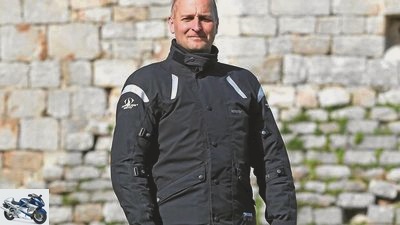
Jahn
The textile combination Destiny Evo / Faith Evo by Stadler.
Providers: Stadler, phone 0 85 43/9 62 00, www.stadler-bekleidung.de; Price: Jacket from 999 euros, trousers from 649 euros, complete from 1648 euros, ten percent surcharge for oversizes; Sizes: Men 48 to 62, women 38 to 46, available in between sizes and made to measure; Colour: Black; Weight: 7.9 kg (size 52); Country of Manufacture: Germany; Furnishing: Outer jacket and pants made of Gore-Tex laminate, inner jacket and pants made of Cordura Air fabric
Fit / comfort
“Two-in-one suit” that can be worn smoothly in a wide range of sizes. Even the standard clothing sizes appeal with their perfectly tailored circumferences, arm and leg lengths. Mobility decreases noticeably with the Gore-Tex overalls and the high total weight.
Weather protection
Great in summer and when it rains. On cool days, due to the lack of an integrated thermal lining, a correspondingly warming combination of base and mid-layer must be used.
security
It couldn’t be better: anatomically shaped protector set including hip and back protection with first-class cushioning.
Equipment / processing
Flawlessly crafted, but few extras.
Conclusion
Innovative touring combination “from Germany”. The functionally equipped, light summer suit is combined with a solid Gore-Tex cover on rainy days. Very nicely made,
exemplary looking protector set.
MOTORRAD verdict: very good, test winner
The protectors in the test
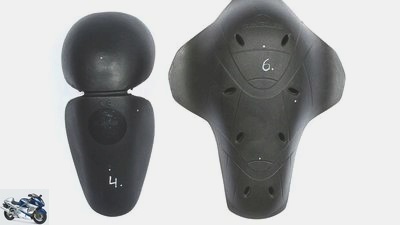
mps photo studio
Minimal versus optimal: joint protector of the Rev’it combination (left) compared to the Stadler bone protector.
Expensive does not automatically mean great: When it comes to protectors, the upper class continues to have a fatal red pencil policy. As a rule, a maximum of three joints (shoulder, elbow and knee) are protected by real protectors. With most of the suits in this test, you can feel more or less thick padding in the back and hip regions, but they usually cannot really protect you. Because only real protectors that are certified according to the standard can do that. To check this, it is worth taking a look inside the suit: take the pads out and see whether they are actually labeled as protectors.
Joint protectors must be tested in accordance with the European standard EN 1621-1, which has now finally been in place since July 1, 2013
a tightened form. If the protector is already certified according to the new standard, the marking must refer to the year 2012 (see photo above). So far, only Rukka and Stadler have been in this test. Hardly anything has changed in the basic procedure. To check the shock absorption properties, a five-kilo drop weight from a height of one meter rushes in free fall with an energy of around 50 joules onto the protector. Below this, an anvil registers the residual force that is passed through. Up to now, a maximum of 35 kilonewtons (kN) has been permitted on average.
Bones can break at less than 10 kN
To illustrate: A bone can break at less than 10 kN. The revision of the standard has now introduced two protection classes. For protectors that are approved according to level 1, the permissible value is still 35 kN. At level 2, the permissible residual force drops to 20 kN. This finally reacted to the state of the art at the European level. Because joint protectors that easily undercut the high limit of 1998 have been on the market for years.
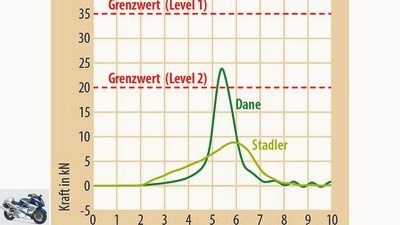
BILLION
Old versus new: Dane protector with a steep increase in force, Stadler with a gently increasing damping curve.
However, it will be a few years before the newly certified joint protectors become established. There is no obligation to use only newly certified protectors from now on. The majority also forego real back protection in this test. Only Ixs, Rukka and Stadler have real back protectors. All others have so far still clad the corresponding pocket in the jacket with an alibi pillow and only offer the installation of a suitable CE-standardized protector for an extra charge.
There are also two protection classes in the standard for back protectors. The basic test procedure is essentially the same as that for joint protectors. But the limit values are already much more stringent here. At level 1, an average of 18 kN must not be exceeded, for level 2 a maximum of 9 kN is permitted.
Adhering to this stricter limit is hardly difficult for a provider. There are already back protectors where the residual force is less than 5 kN. It is much more important to look at the actual protective surface, which is calculated using a shoulder-to-hip distance specified on the back protector. Because protectors that are much too small for the clothing size are often used.
Buy protectors on markt.motorradonline.de
Conclusion and final evaluation
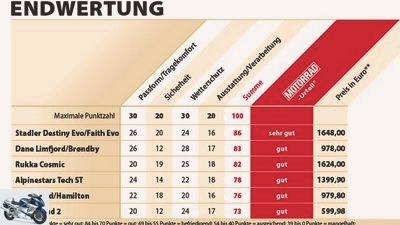
BILLION
The final score of the product test.
Conclusion:
The result is clearly documented: In the upper house of textile manufacturers, they basically understand how to do a good job. That is also the result of the 4,000-kilometer lap that each individual suit was wound on as part of the MOTORRAD tire test.
There were no real failures, neither due to the ingress of moisture when driving in the rain nor in daily use when opening and closing the press studs, zips and Velcro fasteners, etc. So all sunshine? No, homework is in the second column: More and better protectors are needed!
Related articles
-
All-weather motorcycle textile suits in the test
mps photo studio 23 pictures mps photo studio 1/23 Evolution in joint protectors: Bering (above) with a small protective surface and weak damping; easy…
-
Buying tip textile suits (MOTORRAD 17-2013)
Jahn clothing Station wagons, jackets & pants Buying tip textile suits (MOTORRAD 17/2013) Buying tip textile suits (MOTORRAD 17/2013) Dane Limfjord / Br…
-
Product test: high-end textile suits
Jahn clothing Station wagons, jackets & pants Product test: high-end textile suits Product test: high-end textile suits A comparison of five luxury-class…
-
Product test: long-distance travel textile suits
Herder clothing Station wagons, jackets & pants Product test: long-distance travel textile suits Product test: long-distance travel textile suits…
-
Nine classic driver’s suits made of cowhide in the test, plus care tips for your leather suits
Lohse clothing Station wagons, jackets & pants Nine classic driver’s suits made of cowhide in the test, plus care tips for your leather suits Product…
-
Sdun clothing Station wagons, jackets & pants Product test: textile jackets Product test: textile jackets Jackets for winter Icy outside, cozy and warm…
-
Product test: leather jackets from 300 euros
Sdun clothing Station wagons, jackets & pants Product test: leather jackets from 300 euros Product test: leather jackets from 300 euros The Wild One…
-
Test textile suits between 700 and 2168 euros
markus-jahn.com 6th pictures Jahn 1/6 6th place: Dane Fureso / Thyro, 948 euros, MOTORRAD judgment “Good”. Jahn 2/6 5th place: IXS Clermont / Willmore,…
-
Comparative test of textile suits 2012
Jahn clothing Station wagons, jackets & pants Comparative test of textile suits 2012 Product test: upper-class textile suits in comparison The top ten…
-
clothing Station wagons, jackets & pants Comparison test leather suits Comparison test leather suits What’s the point of kangaroo leather? Kangaroo…